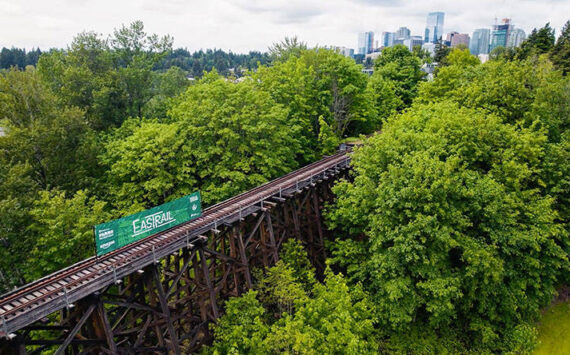If you go near the Waterfront or Pioneer Square, you know what it’s like to get stuck behind one of the plodding Percheron-pulled carriages, the slowest form of sightseeing in town. Or you may get stranded behind the red “Waterfront Trolley” bus, or the more lurid amphibious “Duck.” If you live in a Lake Washington mansion (yeah, right!), the boat tourists will gawk at your back door, along with Bill’s and Kenny G’s. If you live downtown, you may be fretting over Kenmore Air’s proposal to run floatplane scenic tours off the downtown Ivar’s pier. (At last word, Kenmore had put the idea on hold—fearing perhaps a costly appeal.) And a few weeks ago, I saw a big Gray Line tour bus take the corner at Madison too sharply and tear the fender off an econobox. Welcome to tour city, where all the town’s a stage and all of us poor fixtures on it. Tour traffic used to be a minor summertime nuisance, like Market crowds; now it’s a serious obstacle that endures, somewhat diminished, right through the damp months. You can’t blame the rubes for wanting to see the sights, and it’s probably better that they all pile into buses than wander in their own cars. Still, you gotta wonder if the city isn’t giving the tour operators a little too blanche a carte. The horse carriages might be tolerable on Alaskan Way (if parked tour buses didn’t routinely block one lane)—but on busy First Avenue, with only one lane each way? And does Gray Line really need to use extra-high, jumbo “Premier Motorcoaches,” which loom even over Metro’s buses and take streets Metro doesn’t take. There’s a reason for their height, explains Gray Line’s Vanessa Nicholson: loftier views and more comfort. But outside, they’re street- and view-blockers and, sometimes, menaces. Half-size buses would intrude less—and even give a few more drivers jobs.
Love’s lofts lost
Still don’t believe the US government is serious about building a new courthouse in Seattle? Believe it. On August 21, without fanfare, the feds condemned their chosen site—the block between Seventh and Eighth avenues and Stewart and Virginia streets, kitty-corner to the new Seattle Police West Precinct.
That condemnation didn’t go down easy. The Vance family’s Avanti Properties wanted more than $20 million for the block, but the General Services Administration would pay only $17 million—about what it wanted to pay several years ago for its first choice, the downtown Seattle Public Library block. (The library also balked at the price, but didn’t get condemned.) “We’ve appealed,” says Avanti partner Neal Vance.
In the meantime, the feds have begun evacuating the only building left on the site, a moderately picturesque old clothing factory/warehouse gone to loft space. For starters, they evicted all the artists living there illegally, thus saving relocation payments; Seattle’s shrinking supply of artist space just shrank a little more.
The GSA plans to clear the building by December, then demolish it and lay a(nother) pay parking lot in the interim. NBBJ is to show design concepts early next year, with a final design coming in June. Thence, if Congress smiles, construction is to begin in October 2000 and be completed in November 2003. If you must commit any federal crimes, wait and enjoy the best accommodations at your trial.
Bill DuBray, the GSA’s regional executive director, says the new Seattle courthouse will be “spectacular,” but “in line with Congress’ [spending] limits,” like the one going up in Portland—not lavish (and controversial) like the new Boston and New York courthouses. But the siting is ironic on several scores. The library board considered putting the new main library on this same site, which offered advantages other sites lacked: easy freeway and transit access, level ground, and relatively low cost. But it decided this was too far off the “downtown core” and opted to rebuild on the current library block (and move twice). The feds, with longer vision, foresee the core growing out to the site. Now that Pacific Place has leapfrogged Sixth Avenue, that’s nearly happened.
Four years ago, the block where the new palace of law will stand was a notorious mecca of low-level lawlessness. The loud, often violent carousing in its south parking lot, across the street from Jerseys Sports Bar, helped provoke the still much-resented abatement ordinance targeting nightclubs. But it also had a gentler history; the moderately picturesque edifice that’s about to be demolished is named the Love Building, after the old Love Furniture Co. Maybe they should call the courthouse that.
Why Boeing only builds planes
When [Boston] set out to modernize the [streetcar] system, the MBTA made the same mistake [San Francisco’s] Muni did—it bought sleek, modern-looking Boeing-Vertol light-rail vehicles that proved to be finicky and fragile.
The cars were designed for both San Francisco and Boston as part of a federally sponsored project to design a new US standard streetcar, the first such attempt since the early 1930s.
As in San Francisco, the Boeings were a disaster for Boston. Derailments, breakdowns, and delays became commonplace on the Green Line. . . .
Today, only 55 of the Boeing cars are still in use—all of them completely overhauled by outside contractors and all reserved for peak commuting hours. Despite the overhaul and their limited use, ‘they are still the worst-performing cars in the system,’ said Mulbern, adding that they will be completely phased out next year.
—”Boston Spent Billions But Fixed Transit,” Richard Berkowitz, The San Francisco Chronicle (9/10/98)
Tangled up in blue
Whoops. That was “Don’t Think Twice (It’s All Right),” not “It’s All Over Now, Baby Blue,” that had people singing along and waving lighters at the Puyallup Bob Dylan concert mentioned last week.








